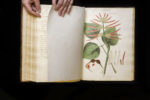 A manuscript filled with brightly colored and realistic drawings of Cuban flora lost for nearly two centuries has been found in the Cornell University Library. Written by Nancy Anne Kingsbury Wollstonecraft during a trip to Cuba in 1826, the three-volume manuscript contains 121 vivid illustrations accompanied by 220 pages of detailed descriptions of the plants she encountered.
A manuscript filled with brightly colored and realistic drawings of Cuban flora lost for nearly two centuries has been found in the Cornell University Library. Written by Nancy Anne Kingsbury Wollstonecraft during a trip to Cuba in 1826, the three-volume manuscript contains 121 vivid illustrations accompanied by 220 pages of detailed descriptions of the plants she encountered.
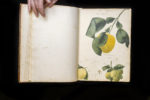 Born in New Hampshire, Wollstonecraft was married to Charles Wollstonecraft, brother of pioneering women’s rights advocate Mary Wollstonecraft and uncle of Frankenstein author Mary Shelley. Charles died in 1817 and Nancy moved to Matanzas, Cuba, where there was a community of American expatriates seeking to improve their health in the sunny climes. In 1826, she compiled a manuscript whose handwritten title page read Specimens of the Plants & Fruits of the Island of Cuba by Mrs. A.K. Wollstonecraft.
Born in New Hampshire, Wollstonecraft was married to Charles Wollstonecraft, brother of pioneering women’s rights advocate Mary Wollstonecraft and uncle of Frankenstein author Mary Shelley. Charles died in 1817 and Nancy moved to Matanzas, Cuba, where there was a community of American expatriates seeking to improve their health in the sunny climes. In 1826, she compiled a manuscript whose handwritten title page read Specimens of the Plants & Fruits of the Island of Cuba by Mrs. A.K. Wollstonecraft.
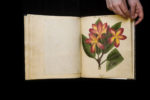 The work was known only from third party references, just two of them contemporary and the second of those a report of the first one. The April 1828 issue of New York Farmer described the compendium glowingly.
The work was known only from third party references, just two of them contemporary and the second of those a report of the first one. The April 1828 issue of New York Farmer described the compendium glowingly.
Introductory work on the Botany of Cuba. — A Lady has occupied herself for several years in deleniating [sic] and describing the more select vegetables growing on this interesting island. Three quarto volumes of descriptions and drawings have been sent to New York, by Nathaniel H. Carter, Esq. corresponding secretary of our Horticultural Society, from
Havana. The figures are carefully colored from the living specimens ; and they appear to have been executed not with correctness merely, but elegance. The history which accompanies each is brief, but sententious and comprehensive; containing the leading facts and circumstances relative to the production. The author of this beautiful and instructive performance, is MRS. WOLSTONCRAFT ; and it may be safely said that it is fully equal to the plates which embellish the celebrated book on the insects of Surinam and the plants they feed upon, by SYBELLA MERIAN. Mrs. Wolstoncraft’s work differs from the other by a total omission of the entomology ; but it is incomparably more scientific. The class, order, genus, and species are distinctly and skilfully [sic] noted, both according to the systems of
Linnaeus and Jussieu, with frequently the Spanish or aboriginal synonym or common name. It is intended to publish this splendid work, if an adequate subscription can be procured ; and after the successful efforts in bringing forward the superb publications of WILSON and BONAPARTE on ornithology, it may be reasonably expected that such a charming addition to botany, will find abundant patronage. The attention of the fair sex is earnestly invited to this subject.
She included more information than just the common name. Wollstoncraft wrote detailed notes on traditional indigenous uses for plants, for example recording that roots of the soursop tree were used to make an antidote for fish poisoning and that its leaves were used to fight parasites and seizures.
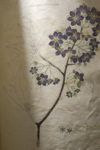 Unfortunately that adequate subscription never was procured and the manuscript remained unpublished. Nancy Wollstoncraft died in 1828. She was 46 years old and her life’s work wasn’t quite complete yet. There were some unfinished illustrations, unidentified specimens, notes and draft pages inside the volumes. The manuscript remained in the family, a cherished heirloom, for almost a century.
Unfortunately that adequate subscription never was procured and the manuscript remained unpublished. Nancy Wollstoncraft died in 1828. She was 46 years old and her life’s work wasn’t quite complete yet. There were some unfinished illustrations, unidentified specimens, notes and draft pages inside the volumes. The manuscript remained in the family, a cherished heirloom, for almost a century.
Its importance was recognized but only by reputation. Later scholars included Specimens of the Plants & Fruits of the Island of Cuba in their publications as a significant work based on that original 1828 reference, but none of them ever laid eyes on it.
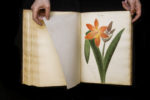 Emilio Cueto, a retired attorney, collector and scholar of Cuban history, set out to track it down. It took two decades for his dogged chase to find its quarry. The diverse spellings of the author’s last name, the occasional use of her maiden name and her first name being recorded as both Anne and Nancy, made searching through catalogues challenging, and there is very little extant information about her life to enable a trace through historical and genealogical records.
Emilio Cueto, a retired attorney, collector and scholar of Cuban history, set out to track it down. It took two decades for his dogged chase to find its quarry. The diverse spellings of the author’s last name, the occasional use of her maiden name and her first name being recorded as both Anne and Nancy, made searching through catalogues challenging, and there is very little extant information about her life to enable a trace through historical and genealogical records.
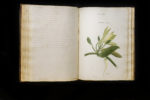 In 2018, he hit paydirt. Cueto found a catalogue entry that matched the manuscript at Cornell University Library’s Division of Rare and Manuscript Collections (RMC). Nancy’s last name was spelled “Wollstonecroft” in the entry, a reasonable interpretation of the cursive script on the title page, which is why it hadn’t been recognized earlier. Cueto flew up to Ithaca, New York, with collaborator Judy Russell, dean of university libraries at the University of Florida, and at long last put eyes on Specimens of the Plants & Fruits of the Island of Cuba. It turns out to have been safely ensconced in the RMC since 1923 when Benjamin Freeman Kingsbury, a descendant of Wollstonecraft’s and Cornell professor, donated it to the library.
In 2018, he hit paydirt. Cueto found a catalogue entry that matched the manuscript at Cornell University Library’s Division of Rare and Manuscript Collections (RMC). Nancy’s last name was spelled “Wollstonecroft” in the entry, a reasonable interpretation of the cursive script on the title page, which is why it hadn’t been recognized earlier. Cueto flew up to Ithaca, New York, with collaborator Judy Russell, dean of university libraries at the University of Florida, and at long last put eyes on Specimens of the Plants & Fruits of the Island of Cuba. It turns out to have been safely ensconced in the RMC since 1923 when Benjamin Freeman Kingsbury, a descendant of Wollstonecraft’s and Cornell professor, donated it to the library.
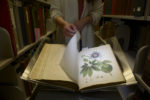 Now Nancy Wollstonecraft’s masterpiece has finally been published, not on paper but in pixels. Instead of the modest subscription run that was the best she could have hoped for, everyone in the world can see the fruits of her labours in high resolution. All three volumes have been digitized and uploaded to HathiTrust: Volume 1, Volume 2, Volume 3. You can browse every page online, or download entire volumes in pdf form.
Now Nancy Wollstonecraft’s masterpiece has finally been published, not on paper but in pixels. Instead of the modest subscription run that was the best she could have hoped for, everyone in the world can see the fruits of her labours in high resolution. All three volumes have been digitized and uploaded to HathiTrust: Volume 1, Volume 2, Volume 3. You can browse every page online, or download entire volumes in pdf form.
Great find! – However, maybe it is worth noticing that Maria Sibylla Merian, who had e.g. described the plants and insects of Surinam, had been born in 1647AD, and Linnaeus died in 1778 (i.e. while Maria Sibylla had already been dead for more than 60 years).
Merian published her first book of natural illustrations in 1675, almost 200 years earlier, and it is indeed fair to assume that Linnaeus and others were acquainted to her works. The Dutch network of publishers was rather advanced, and likewise set standards.
Maria Sibylla’s ‘Metamorphosis insectorum Surinamensium’ was published in Latin(!) 😉 [and in Dutch], …and as the title indicates primarily on the Entomology, but with the corresponding plant description(s).
very cool :hattip: